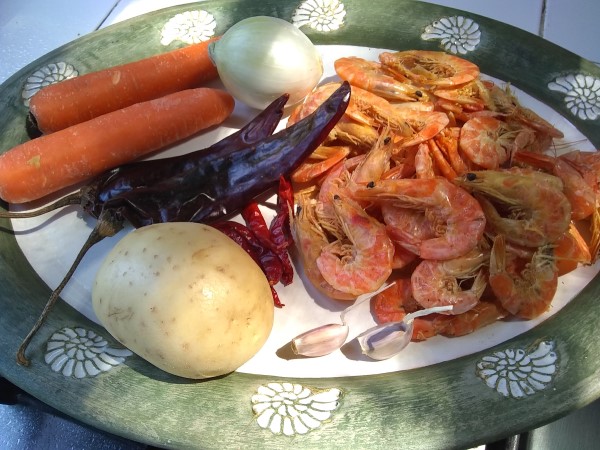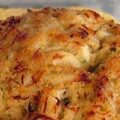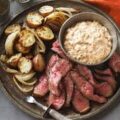In the interior of Mexico a two hour lunch is still common. It is also common to go to a cantina for a cerveza—or two—before going home for lunch. In Mexico City however, most people do not go home for lunch, distances and traffic are obstacles, so the whole lunch time can be devoted to la botana, the name given to the “free food” that comes along with the cervezas in las cantinas. This is a slow time to see friends, grab a bite, maybe take care of a business transaction, or only a way to fight the midday heat. This activity can last an hour or the whole afternoon if you decide to call it a day. The slowly disappearing art of conversation is practiced there or time could be spent watching a soccer game, playing dominoes or listening to live music—last time I went they even had a karaoke! Foreigners that I have taken to experience la botana ritual are flabbergasted. I get questions such as: are they still going home to eat? How can they go back to the office? Are they driving home?… La botana is a social phenomenon product of a marketing scheme that cantinas use to sell more: offering free food. Order a beer and you get a dish, a second one and you get another dish, small portions is the rule but the list can reach 8 or ten courses! I usually order a shot of Tequila or Mezcal and a beer as a chaser, so I get two dishes at once! The more you drink the more you save!… in food that is… That’s why people stay there for hours having a good time! A joyful carpe diem philosophy or La joie de vivre Mexicaine! Some other time we can venture into discussing another nicety: the siesta time concept…
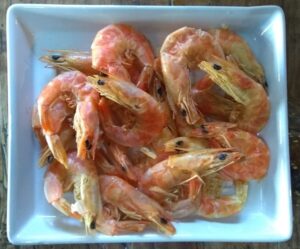
Sun dried shrimp
The menu of la botana is Mexican in principle with clear influence by Spanish cuisine, in the line of Tapas bar food but on the fiery side—so you drink more. Caldo de camarón is the quintessential first course in a cantina, as if our culture wanted to make sure you don’t go home without it in case you decide to leave after only one cerveza. What is caldo de camarón? It is a sun dried shrimp broth with diced carrots and potatoes, its aromatics include onion and garlic, spiced with chile guajillo, and at times a bit of chile de árbol for extra heat—recipe below.
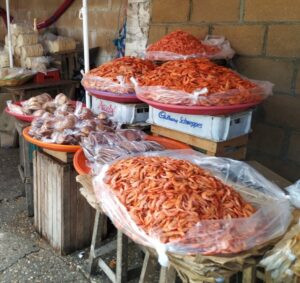
Dried shrimp in an open market by Paulina Lordméndez commons.wikimedia.org 22
The shrimp sun drying technique did not originate in Mexico, however. It came from far away and it wasn’t Europe. We need to remember that the Spaniards arrived in America—the continent—while Christopher Columbus was looking for a shorter route to Asia where trade with Europe was taking place. Silk, textiles, exotic woods, fabrics, pineapples, rice, saffron, pepper and other spices were among the traded goodies. After the Spaniards arrived at la Nueva España through the Atlantic in 1492, they later crossed the territory and ran into the Pacific Ocean in what is today Acapulco. It was Miguel López de Legazpi who set sail in 1565 from the American Pacific to Asia. This new route connected the Philippines—then already a colony of Spain—with Europe through today’s Acapulco in the Pacific and the Port of Veracruz in the gulf. La Nao de China or Galeón de Manila were the names of the ships that made the trip through the pacific and as you can guess, one of the foods traded was sun dried shrimp from Asia. Since shrimp was abundant in the coasts of the new world, Spaniards ended up importing the technique and native Americans started to sun dry shrimp in the coasts of Mexico. Sun dried shrimp became an export product and also part of the diet of the new world. The trade with Asia continued through La Nueva España through the new discovered route, enriched with the foods, spices, herbs, and exotic woods found in what is today Mexico.
At one point in time, the beer making process was brought from Europe. Spaniards put beer in the new world socializing table along with a sun dried shrimp soup, where their purpose was to feed and entertain. Was this a perfect European-Asian marriage of food and drink with a honeymoon in America? I submit it was…
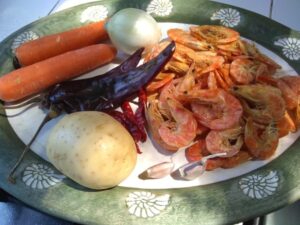
Ingredientes del caldo de camarón
Sun dried shrimp continues to be produced today in the Pacific coast of Mexico and in the gulf. Different varieties of shrimp and different regions determine the harvest season, this having an impact on availability and the market price of the fresh version. Sun dried shrimp however is available year round. It takes three kilos of fresh shrimp to make one kilo of dried shrimp. The process involves rinsing and boiling the fresh shrimp for a few minutes then exposing it to the sun for about 5 hours while tossing and turning it, the antennae are removed, salt is added then it is packed and put into refrigeration for aging. The sun drying process is all done manually but there are also industrial plants that use gas furnaces to do the drying and all the process is done under a roof, making it safer, health wise and more efficient.
Besides caldo de camarón, sun dried shrimp is used in Mexican dishes prepared during lent and Christmas such as shrimp cakes to accompany romeritos (Suaeda Spp.) en mole, adding a sui generis flavor. The rest of the year can be found flavoring moles, pipianes, tamales, rice and other regional specialties. Famous are the shrimp from the Tehuantepec, Oaxaca region, Escuinapa, Sinaloa and the State of Campeche, along with everybody’s claims that theirs are the best.
As in the past, the marriage of foreign foods and drinks in Mexico continues, cerveza and caldo de camarón still meet in a cantina everyday somewhere in Mexico, where sometimes I run into them, and I always thank God for the encounter… Salud!
Recipes Camarón Seco
Please note: dehydrated shrimp can be found in Asian, Cajun, and Mexican aisles in supermarkets, and little neighborhood stores. If buying online, read the buyers’ comments and ratings. A dried shrimp of good quality must be large and complete. Avoid the small ones and the ones that are broken into many pieces.
Caldo de Camarón
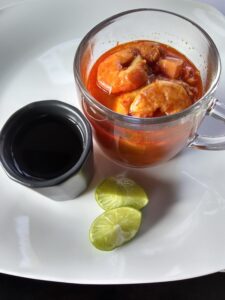
Caldo de camarón
As in all dry shrimp recipes, there is no waste since heads, legs and tails are ground and added to sauces to enhance the flavor of the dish. Leftovers of this broth can also be used 50/50 with water in cooking rice for a strong spiced shrimp flavor.
Ingredients:
- 6 Oz. Dried shrimp
- 3 Chiles guajillo stemmed, seeded and deveined
- 3 Chiles de Árbol (optional) stemmed, seeded and deveined
- 1 Medium size potato boiled peeled and diced
- 2 Carrots boiled peeled and diced
- ½ Onion finely chopped
- 2 Cloves garlic minced
- Cooking oil
- Salt to taste
Instructions:
- Rinse the shrimp and the chiles. Remove heads, legs and tail on the shrimp and throw those bits in the blender. Reserve.
- Place the chiles and clean shrimp in hot water to rehydrate in a covered container for about 20 minutes. Fry them lightly the onion and garlic in the pot where you are going to make the caldo de camarón and reserve.
- In the blender with the heads, legs and tails add the rehydrated chiles and make a sauce using the rehydrating water.
- Add the sauce, the potato, the carrots and the rehydrated shrimp in the pot where the onion and garlic have been fried and bring it to a boil. You may need to add water at this time. Lower the heat and simmer for 10 minutes.
- Check for salt and add if necessary. You should get a light but flavorful broth. Serve on a small glass or cup. Enjoy!
Yield: 6 portions
Heat scale: medium to hot
Pozole de Camarón
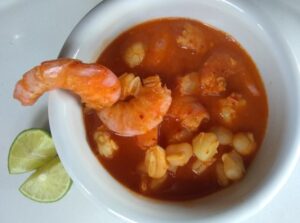
Pozole de Camarón seco
Ingredients:
- 6 Oz. Dried shrimp
- 12 Oz. Hominy boiled
- 3 Chiles guajillo stemmed, seeded and deveined
- 3 Chiles de Árbol (optional) stemmed
- ½ Onion finely chopped
- 2 Cloves garlic minced
- Cooking oil
- Salt to taste
Instructions:
- Rinse the shrimp and the chiles. Remove heads, legs and tail on the shrimp and throw them in the blender. Reserve.
- Place the chiles and clean shrimp in hot water to rehydrate in a covered container for about 20 minutes.
- Fry lightly the onion and garlic in the pot where you are going to make the pozole and reserve.
- In the blender with the heads, legs and tails add the rehydrated chiles and two to three tablespoons of boiled hominy, and make a sauce using the rehydrating water. If thicker consistency is desired you may add more hominy.
- Add the sauce, the rest of the hominy and the rehydrated shrimp in the pot where the onion and garlic have been fried and bring it to a boil, check consistency; you may need to add water.
- Lower the heat and simmer for 15 minutes. Check for salt and add if necessary. You should get a hearty and flavorful soup. Enjoy!
Yield: 6 portions
Heat scale: medium
Camarones en Salsa de Chile Ancho y Guajillo con Nopales
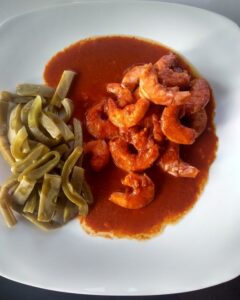
Sun dried shrimp with ancho Guajillo sauce and nopales
Ingredients:
- 6 Oz. Dried shrimp
- 3 Chiles ancho stemmed, seeded and deveined
- 3 Chiles guajillo stemmed, seeded and deveined
- 6 Nopales paddles in strips, boiled, strained and rinsed
- ½ Onion finely chopped
- 2 Cloves garlic minced
- Cooking oil
- Salt to taste
Instructions:
- Rinse the shrimp and the chiles. Remove heads, legs and tail on the shrimp and throw them in the blender. Reserve.
- Place the chiles and clean shrimp in hot water to rehydrate in a covered container for about 20 minutes.
- Fry lightly the onion and garlic in the pot where you are going to make the camarones en salsa and reserve.
- In the blender with the heads, legs and tails add the rehydrated chiles and make a sauce using the rehydrating water.
- Add the sauce from the blender and the rehydrated shrimp in the pot where the onion and garlic have been fried and bring it to a boil, you may need to add water.
- Lower the heat and simmer for 10 minutes. Check for salt and add if necessary. You may add the nopales to the pot or serve them separate. Enjoy!
Yield: 6 portions
Heat scale: medium
Latest posts by José C. Marmolejo (see all)
- Unconventional Seafood Salsas - 04/25/2022
- Cocineras Tradicionales: The Traditional Cooks of Mexico - 04/01/2022
- Carnitas Calientes - 03/11/2022

